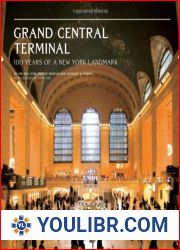
BOOKS - Grand Central Station: The History of New York City's Famous Railroad Termina...


US $7.88

840934

840934
Grand Central Station: The History of New York City's Famous Railroad Terminal
Author: Charles River Editors
Year: February 9, 2015
Format: PDF
File size: PDF 2.0 MB
Language: English
Year: February 9, 2015
Format: PDF
File size: PDF 2.0 MB
Language: English
*Includes pictures *Includes temporary accounts of Grand Central's history and construction *Includes a bibliography for further reading *Includes a table of contents "In Grand Central you cannot shilly shally or dilly dally. Everyone rushes and dashes and zips and zaps and whizzes like crazy and oh what a dizzy and delightful place." - Maira Kalman, Next Stop Grand Central Of all the great cities in the world, few personify their country like New York City. As America's largest city and best known immigration gateway into the country, the Big Apple represents the beauty, diversity and sheer strength of the United States, a global financial center that has enticed people chasing the "American Dream" for centuries. Given that background, it's fitting that the city's most iconic railroad station, Grand Central Terminal, is the largest in the world, sprawling across nearly 50 acres with over 40 platforms and 65 lines. Moreover, in addition to handling hordes of bustling commuters, it's now a classic tourist spot that attracts tens of millions of visitors annually. As author Tom Wolfewould so eloquently put it, "Every big city had a railroad station with grand - to the point of glorious - classical architecture - dazzled and intimidated, the great architects of Greece and Rome would have averted their eyes - featuring every sort of dome, soaring ceiling, king-size column, royal cornice, lordly echo - thanks to the immense volume of the spaces - and the miles of marble, marble, marble - but the grandest, most glorious of all, by far, was Grand Central Station." Like Manhattan itself, Grand Central Station, which recently celebrated its 100th birthday, manages to be both historic and modern. Built upon the site of a former railroad depot, the current structure and layout was phased in over the course of nearly a decade in the early 20th century. Whereas the first railroad stations depressed the value of land nearby in the 19th century, the location of Grand Central was a boon that actually helped bring about construction all across Midtown, including the nearby Chrysler Building, thereby serving to transform the cityscape altogether. As Central Station took on increasing importance, the cultural significance of the terminal also changed as New Yorkers began to look at the place as a work of art itself. Grand Central has since been stocked with art in all shapes and sizes, with galleries that call it home and special events being held there. Thus, when proposed changes or even possible replacements for Grand Central were bandied about in the 1960s, they met widespread opposition, including from former First Lady Jackie Kennedy, who asked, "Is it not cruel to let our city die by degrees, stripped of all her proud monuments, until there will be nothing left of all her history and beauty to inspire our children? If they are not inspired by the past of our city, where will they find the strength to fight for her future? Americans care about their past, but for short term gain they ignore it and tear down everything that matters. Maybe... this is the time to take a stand, to reverse the tide, so that we won't all end up in a uniform world of steel and glass boxes." As a result, Grand Central was maintained as a landmark and has instead undergone restorations. Grand Central The History of New York City's Famous Railroad Terminal chronicles the construction and history of the Big Apple's most famous train station. Along with pictures of important people, places, and events, you will learn about Grand Central like never before, in no time at all.














































